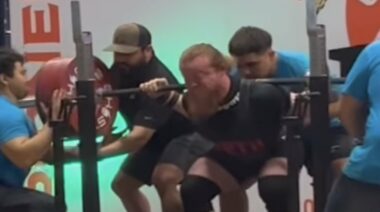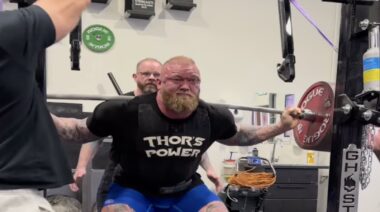The squat is one of the most basic movements the human body can perform. Revered as the king of all exercises, its reign has spanned decades atop the iron game. From powerlifting to bodybuilding to CrossFit, the squat is a vital component of anyone’s training repertoire. If you want to be strong, it has been said, you must squat. It engages the entire lower body and core, increases excess post-exercise oxygen consumption (EPOC), and is perhaps the most functional movement around.
The squat is one of the most basic movements the human body can perform. Revered as the king of all exercises, its reign has spanned decades atop the iron game. From powerlifting to bodybuilding to CrossFit, the squat is a vital component of anyone’s training repertoire. If you want to be strong, it has been said, you must squat. It engages the entire lower body and core, increases excess post-exercise oxygen consumption (EPOC), and is perhaps the most functional movement around.
However, proficiency in the squat takes time to develop. One cannot simply slap on some weight, walk up to the bar, and begin making substantial progress. The squat requires a slew of technical considerations, form corrections, and specific, nuanced individual adjustments to perform correctly.
So what if you’re one of the unlucky souls that just can’t get it right? What if you keep banging your head against the wall, trying to figure out why you suck at squats? The truth is that you may need to hang up the traditional back squat. See if you fit into any of these categories, and decide for yourself.
You Are an Injury Waiting to Happen
Some of us just aren’t physically cut out to squat. We are tall, have unusually long torsos or legs, or a higher center of gravity that tilts us too far forward, stressing our lumbar spine. Maybe you’ve tried squatting with plates under your heels, placed the bar lower or higher on your back, or used special curved bars to try and work around your lack of squat-worthiness. But despite all that, you still come away from a squat session with aches and pains, or worse.
Or it may be that a past injury or structural flaw in your physiology inhibits you from comfortably performing the squat. Herniated or bulging discs, pelvic pain or tightness, or past knee or ankle injuries have relegated you to be benched from squats.
What you should do: The first step is to have a qualified, competent coach evaluate your form and technique. He or she will be able to observe details that you may be unaware of. They will be able to shore up any shortfalls or weaknesses that are making your problem worse, or make adjustments to your mechanics that will open the door to squats for you.
Past that, go see a licensed physical therapist or athletic trainer about past injuries. They may be chronically plaguing your efforts in the gym, and learning how to work around them (or resolve them altogether) will go miles toward your potential for progression. These professionals can help you more accurately determine if you’re a good candidate for the squat. It may be a bit time consuming and involved, but the more you know about your individual situation, the better.
Your Form Could Use an Overhaul
If you’ve ruled out any structural flaws and are ruled free of injury, then you may simply be doing it wrong. As mentioned earlier, technique while performing the squat is paramount. Your hips, knees, lumbar, abdominal area and everything in between all have to work together to make the squat work for you. Leaning too far forward, not hinging at your hips correctly, or leaving your core too loose will all compromise the movement. You can only self-correct so much using a mirror and relying on general self-awareness.
What you should do: This is where your trusted coach can help once again. Have a qualified trainer evaluate not only your form and function while performing the squat, but also your postural alignment and mobility—particularly in the lower body. Are your hips, glutes, or calves too tight for proper range of motion? Do you lack core strength and stability? Is your posterior chain the weak link? These are questions that are better answered from a qualified and experienced observer. After your evaluation, work diligently and purposefully to correct any shortcomings before increasing weight or adding any intensifiers to your squat workout.
You Might Do Better With Alternatives
After all of the exhaustive evaluation and critique, you may just be someone who can’t properly squat. You’ve sought professional help and tried to correct the errors they found, but it still feels wrong. You may feel like you’re doomed to never reap the myriad benefits of the granddaddy of all exercises, and be relegated to the dreaded leg press. Do not despair! There are other ways.
What you should do: There are plenty of other options to replace the good ole-fashioned back squat. Some of these alternatives may actually benefit you more than banging your head against the wall trying to perfect the squat.
The Bulgarian split squat is a great replacement for several reasons. It takes pressure off of the lower back, works each leg unilaterally for better strength balance, and it allows you to make less weight feel heavier, de-loading your spine and enabling a more upright position. Other alternative moves include reverse lunges, front squats, goblet squats, trap bar deadlifts, and pistol squats just to name a few.
Your Heart Isn’t in It
Some individuals simply don’t have the desire to squat. They either don’t see the benefits, or simply lack the motivation to put in the time and effort required to learn how to squat correctly. I could fill pages with reasons to squat, but there will always be a few who stand their ground to abstain from practicing. But here’s the thing: if you aren’t motivated to do something as technical as the squat correctly, you probably shouldn’t do it at all.
What you should do: Be honest with yourself about your desire to make the effort to learn to squat correctly. You may need to start all over again, and perform a series of sets each day with just your body weight. Developing this pathway or groove will help map out the exercise, so it will one day become second nature. Failing that, take another look at the variations above.
Don’t Give Up on the Squat
Not everyone is built perfectly to back squat. You may need outside help, or it may be better for your unique physiology to simply find an alternative to adopt. Whatever your plan of action, don’t let the benefits of the squat be a foreign experience. Scrutinize your form and technique, shore up your weak links, and dig deep to uncover the right path to progression.
Another variation to keep you squatting and healthy:






